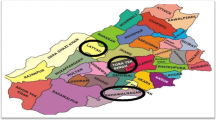Abstract
The cost of illness (COI) approach was used to estimate the private costs to Sri Lankan farmers due to ill health resulting from exposure to pesticides during handling and spraying. Field survey data showed that the costs arising from pesticide exposure are considerable. The data were then used to formulate cost of ill health scenarios for the entire country. The last section of the paper undertakes an econometric analysis to identify the factors responsible for the ill health among farmers exposed to pesticides. The Tobit regression results showed that farmers are in clear violation of the precautions prescribed for handling and spraying pesticides, a situation that calls for urgent action to implement the recommended safety procedures. If not, the costs to the country as well as to the users will be substantial, as shown by the cost estimates generated from the field survey and the limited hospital data available. The environmental externalities are also expected to be high. The results of the study can be useful for developing countries where farmers use hand sprayers, resulting in high exposure to pesticides.
Similar content being viewed by others
References
Amemiya T (1984) Tobit models: a survey. Journal of Econometrics 24:3–61
Annual Health Bulletin (1985–1998) Various issues. Ministry of Health, Colombo, Sri Lanka
Antle JM, Donald CC, Crissman CC (1998) Further evidence on pesticides, productivity and farmer health: potato production in Ecuador. Agricultural Economics 18:199–207
Becker GS (1965) A theory of the allocation of time. Economic Journal 75:493–517
Blair A, Zahm SH (1993) Patterns of pesticide use among farmers: implications for epidemiologic research. Epidemiology 4:55–62
Bramble BJ (1989) An environmentalist view of pest management and the Green Revolution. Tropical Pest Management 35:228–30
Bryman A, Cramer D (1997) Quantitative data analysis with SPSS for windows: a guide for social scientists. Routledge, London
Collins J J, Strauss ME, Levinskas GJ, Conner PR (1993) The mortality experience of workers exposed to 2,3,7,8-tetrachlorodibenzo-p-dioxin in a trichlorophenol process accident. Epidemiology 4:7–13
Crissman CC, Antle JM, Capalbo SM (1998) Economic, environmental, and health tradeoffs in agriculture: pesticides and the sustainability of Andean potato production. Kluwer Academic, Boston
Cuyno LM (1999) An economic evaluation of health and environmental benefits of the IPM program in the Philippines. PhD thesis, Virginia Polytechnic Institute and State University, Blacksburg, VA
Department of Census and Statistics (1983) Sri Lanka census of agriculture, 1982: general report. Ministry of Plan Implementation, Colombo, Sri Lanka
Department of the Environment (1996) Indicators of sustainable development for the United Kingdom. Her Majesty’s Stationary Office, UK
Dinham B (1993) The pesticide hazard: a global health and environmental audit. Zed Books, London
Farmer BH (1977) Green revolution? Technology and change in rice growing areas of Tamil Nadu and Sri Lanka. Macmillan, London
Food and Agricultural Organization (2000) Project concept paper: HEAL: health in ecological agricultural learning, prepared by the FAO programme for community IPM in Asia, Food and Agricultural Organization of the United Nations, Rome, http://www.fao.org/nars/partners/2nrm/proposal/9_2_6.doc
Forget G (1991) Pesticides and the third world. Journal of Toxicology and Environmental Health 32:11–31
Gregory RD, Noble DH, Campbell LC, Gibbons DW (2000) The state of the nation’s birds–1999. Royal Society for the Protection of Birds/British Trust for Ornithology, Cambridge, UK
Jeyaratnam J, Luw KC, Phoon WO (1987) Survey of acute pesticide poisoning among agricultural workers in four Asian countries. Bulletin of the World Health Organization 65:521–527
Mason CF, Ford TC, Last NI (1986) Organochlorine residues in British otters. Bulletin of Environmental Contamination and Toxicology 36:429–436
Ministry of Finance, Bangladesh (1992) Bangladesh economic survey, 1990/91. Government of the Peoples Republic of Bangladesh, Dhakka
Mushkin SJ (1962) Health as an investment. Journal of Political Economy 70(Suppl, October):129–157
Pesticide Registration Office (1995) Unpublished data, Department of Agriculture, Peradeniya, Sri Lanka
Regional Network for the Production, Marketing and Control of Pesticides in Asia and the Far East (RENPAF) (1985) RENPAF Gazette, Special Issue, Metro Manila
Rola AC, Pingali PL (1993) Pesticides, rice productivity, and farmers’ health. International Rice Research Institute, Manila
Sivayoganathan C, Gnanachandran J, Lewis J, Fernando M (1995) Protective measure use and symptoms among agropesticide applicators in Sri Lanka. Social Science and Medicine 40:431–436
United States Environmental Protection Agency (1990) Fish kills caused by pollution, 1977-1987. Draft Report of the US Environmental Protection Agency, Office of Water Regulations and Standards, Washington, DC
Widawsky D, Rozelle S, Jin S, Huang J (1998) Pesticide productivity, host-plant resistance and productivity in China. Agricultural Economics 19:203–217
Wilson C, Tisdell C (2001) Why farmers continue to use pesticides despite environmental, health and sustainability costs. Ecological Economics 39:449–462
Wilson C (2003) Empirical evidence showing the relationships between three approaches for pollution control. Environmental and Resource Economics 24:97–101
World Resources Institute (1998) World Resources, 1998/1999. Oxford University Press, Oxford
Author information
Authors and Affiliations
About this article
Cite this article
Wilson, C. Private costs and the relation between pesticide exposure and ill health: evidence from Sri Lanka. Environ Econ Policy Stud 5, 213–227 (2002). https://doi.org/10.1007/BF03353922
Received:
Accepted:
Published:
Issue Date:
DOI: https://doi.org/10.1007/BF03353922




